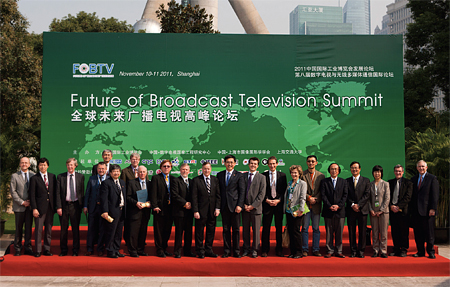A New Era of Global Cooperation

Representatives of FoBTV Founding organizations gather in Shanghai.
Mark Richer is President of the Advanced Television Systems Committee Inc.
When more than 230 TV executives, engineers and government officials gathered in Shanghai for the Future of Broadcast Television conference in November, we reached agreement that terrestrial broadcast TV must continue to evolve. The transition from analog to digital—while a major shift—was only one big step forward.
Delegates to the conference issued a landmark joint declaration at exactly 11:11 a.m. on 11/11/11, agreeing that collaboration on a global approach to the future of terrestrial TV broadcasting would avoid competing standards, overlap, and inefficient deployment of new services. Thirteen broadcast organizations from around the world have called for a joint effort to define new requirements, unify various standards and promote sharing of technologies to benefit developed and under-developed countries—and to conserve resources.
A common theme throughout the summit was that broadcasting—the transmission of digital data to an unlimited number of listeners and viewers—is the most spectrum-efficient means for wireless delivery of popular real-time and file-based content. Existing digital standards serve us well today, but new technical strategies will be required to address next-generation broadcast systems.
Now is the time to work on the next generation of digital TV. Globally, spectrum is being sought after by other industries in virtually every country. That puts pressure on the broadcasting and consumer electronics industries to improve our spectral efficiency.
We know that viewers want to use TV content wherever they go, and the new system will need to address that reality. Viewers are now "on the go," and as broadcast TV reception migrate from the dedicated TV to also include the mobile phone, in-vehicle information and entertainment devices, laptop, and tablet computers, it's also important to remember that those devices will now cross borders. Viewers will expect to be able to get off a plane and immediately tune in to local broadcast services.
The future will be about collaboration. Laboratories run by NHK in Japan, NERC in China, ETRI in Korea, CRC in Canada and others around the world will need to be involved. Our own ATSC 3.0 efforts will mesh well with this international effort and we look forward to working with our colleagues in other standards organizations such as ARIB and DVB. Professional equipment and consumer electronics manufacturers understand the benefits of a global standard. We also welcome non-traditional broadcasters interested in developing new strategies for spectrum efficient standards based systems.
Our timetable will depend on requirements and the regulatory environment, but I am enthusiastic about the ATSC's ongoing efforts, and I'm very optimistic about the potential of working together, rather than separately, with colleagues around the globe to develop the suite of technologies that will keep TV broadcasting relevant for viewers in the years to come.
The professional video industry's #1 source for news, trends and product and tech information. Sign up below.
